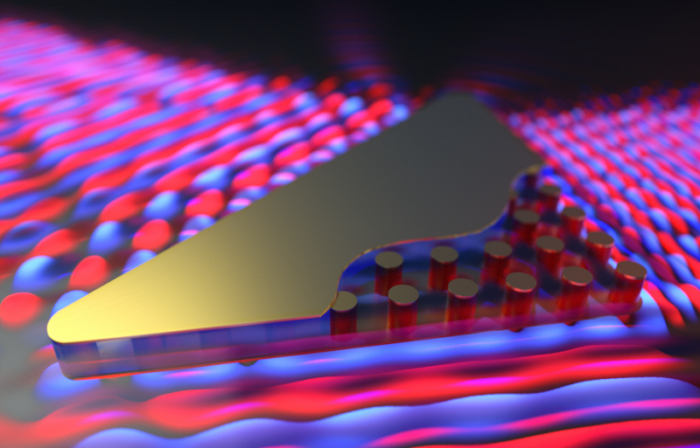Researchers at Harvard’s John A. Paulson School of Engineering and Applied Sciences have announced the first on-chip metamaterial with a refractive index of zero — meaning the phase of light can travel infinitely fast through it.

“Light doesn’t typically like to be squeezed or manipulated but this metamaterial permits you to manipulate light from one chip to another, to squeeze, bend, twist and reduce diameter of a beam from the macroscale to the nanoscale,” said Eric Mazur, the Balkanski Professor of Physics and Applied Physics and Area Dean for Applied Physics at SEAS. “It’s a remarkable new way to manipulate light.”
This new material doesn’t break the rule of relativity. Nothing in our world carries information faster than light. So Einstein is still right about that—for now. What’s new and exciting and different about this discovery, in particular, is how it utilizes another speed that light has; that is, how fast the crest of a wavelength move (phase velocity). This measurement can increase or decrease depending on the material it’s moving through.
Take, for example, water — its phase velocity is reduced as its wavelengths are compressed together. When it exits the water, its phase velocity increases again as its wavelength elongates. The speed by which these wavelengths are slowed down in a specific material is expressed as a ratio referred to as the refraction index. The higher the index is measured to be, the more the material interferes with the transmission of the wave crests of light. Per the earlier example, water has a refraction index of approximately 1.3.
When it is reduced to zero, that’s where the fun starts.
That’s because in a zero-index material, there’s no phase advance; that is, light doesn’t behave like a moving wave traveling through space in a series of crests and troughs. Instead, a zero-index material creates a constant phase, stretching out in infinitely long wavelengths. The only oscillation that occurs happens as a variable of time, not space.
Speaking a bit more generally, a uniform phase allows light to be stretched, squished, and twisted without losing energy. Putting this zero-index material on a chip could bring about several new, exciting applications, ranging from advancements in quantum computing to the introduction of whole new photonic devices.
“Integrated photonic circuits are hampered by weak and inefficient optical energy confinement in standard silicon waveguides,” said Yang Li, a postdoctoral fellow in the Mazur Group and first author on the group’s paper detailing their discovery. “This zero-index metamaterial offers a solution for the confinement of electromagnetic energy in different waveguide configurations because its high internal phase velocity produces full transmission, regardless of how the material is configured.”
So, what exactly is this metamaterial? Breaking it down, it consists of silicon pillar arrays embedded in a polymer matrix and clad in gold film. It can couple to silicon waveguides to interface with standard integrated photonic components and chips.
“In quantum optics, the lack of phase advance would allow quantum emitters in a zero-index cavity or waveguide to emit photons which are always in phase with one another,” said Philip Munoz, a graduate student in the Mazur lab and co-author on the paper. “It could also improve entanglement between quantum bits, as incoming waves of light are effectively spread out and infinitely long, enabling even distant particles to be entangled.”
“This on-chip metamaterial opens the door to exploring the physics of zero index and its applications in integrated optics,” said Mazur.
To learn more, download the team’s paper, which was published in the journal Nature Photonics, under the title On-chip zero-index metamaterials.
Advertisement
Learn more about Electronic Products Magazine





